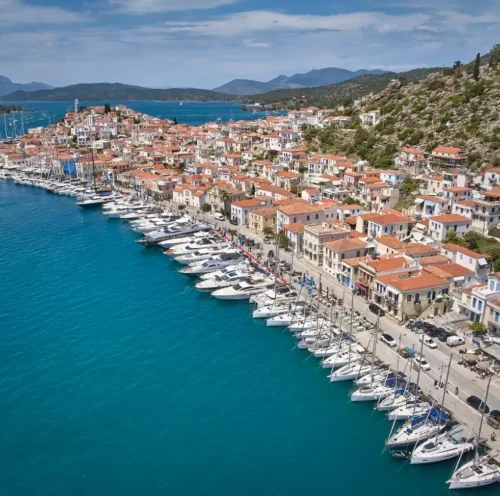Table of Contents
Sailing in Kornati National Park, Croatia
Sailing in Kornati National Park among the uninhabited islets is a yachter’s paradise. They are located off the Dalmatian mainland coast, between Šibenik and Zadar. We took a sailing trip to find out more.
Setting Sail
Backed by centuries-old olive groves, Sali is the biggest village and main port on Dugi Otok island. Pastel-colored houses rim and deep sheltered bay, and eateries buzz with sailing crews on summer evenings. We set sail from here to explore Kornati National Park, an archipelago of 89 rocky islets and reefs.
We passed through the strait between Dugi Otok and Kornat island, after which the Kornati archipelago is named. We had to navigate carefully. In the middle of the strait lies the islet of Katina, with a narrow channel to each side. Once out on the open sea, we sailed by the twin islets of Vela Sestrica and Mala Sestrica. The former is capped by a proud red-and-white-striped lighthouse dating from 1876.
Centuries ago, the Kornati islets were covered by wild oak forests. The Venetians reputedly felled the trees to use as timber for shipbuilding. As a result, the islets became quite barren. Fishermen from the island of Murter began using the islets as refuges for their boats when out fishing. In addition, they grazed sheep here on scanty pastures and built dry-stone walls, dividing the land into fields.
Monument to Kornati Firefighters
On the south side of Kornat island, we sailed below the evocative Monument to Kornati Firefighters. Architect Nikola Bašić designed it to commemorate 12 Croatian firemen who died tragically fighting a wildfire in the summer of 2007. Local stone was used to build walls tracing twelve giant crosses, each 25-meters long and 15-meters wide. Indeed, it is a fine work of abstract geometric art, harmonizing with the contours of the land.
Church of Our Lady of Tarac
Further down Kornat’s south coast, we stopped at the waterside Church of Our Lady of Tarac. This small whitewashed church was built in the 17th century on the ruins of a 6th-century Christian basilica. Local sailors caught out on the Adriatic during storms would have taken refuge here. Every year in early July, the Bishop of Zadar holds a religious service to bless the land and the sea. Locals arrive in dozens of small boats to attend the festivity.
Tureta Fortress
On a hilltop nearby stands the Tureta Fortress, an imposing Byzantine stronghold from the 6th century. It would have overseen the passage of ships in these wild waters. We clambered up the rough rocky slope to the top for fantastic panoramic views over the surrounding seascape.
Mana Film Set
After that, our next stop was the islet on Mana. High above the sea, upon dramatic cliffs, perches what appears to be an abandoned medieval village. However, these are fake ruins. They were built to look like a Greek settlement for a German film, As the Sea Rages (1959). More recently, they featured in the Croatian film Murina (2021), which won the Camera d’Or at Cannes Film Festival 2021.
Vrulje Bay
Finally, we sailed into a deep sheltered bay and moored up in the waterside village of Vrulje on Kornat. Firstly we bought homemade rakija, sun-dried figs, and olive-oil soap scented with sage from a stall on the seafront. Then it was time for dinner – delicious lobster with tagliatelle pasta and a carafe of white wine at Konoba Robinson. The following day we would continue our voyage.



